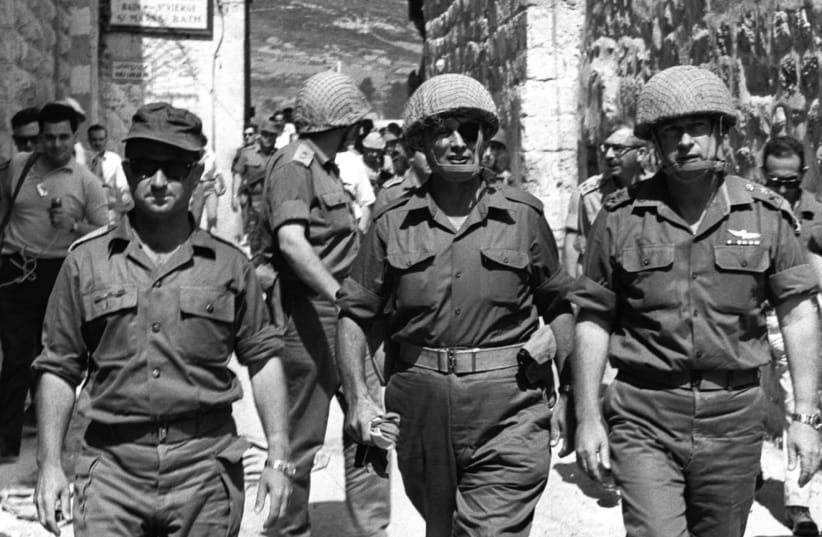The 1967 war revisited
This week’s anniversary of the June 1967 Six Day War offers a moment to reflect upon that momentous military victory and its implications for Israel today.
The forgotten pre-war anxiety
The IDF’s battlefield triumph – involving the conquest of east Jerusalem and the West Bank from Jordan, the Gaza Strip and the Sinai Peninsula from Egypt, and the Golan Heights from Syria – often obscures from memory the pervasive fear and anxiety felt across Israel in the weeks leading up to the conflict.
At the time, Israelis held serious doubts about their country’s ability to deal with the anticipated coordinated onslaught by the neighboring Arab states. Even those confident Israel would prevail expected that victory would come at a dreadful human cost. Emblematic of the ubiquitous apprehension was the preparation of mass graves for the predicted voluminous casualties.
The pessimistic forecasts never materialized, probably because the IDF chose to attack first and caught the Arab armies off guard, though the preemptive strike allowed Israel’s enemies to brand it the aggressor.
The pre-1967 lines
Before the 1967 victory, Israelis viewed their country as exposed and vulnerable. Surrounded on three sides by hostile Arab states, Israel lacked strategic depth: its capital was a border community, and at its narrowest point the country was barely fifteen kilometers wide.
Moreover, the pre-1967 frontiers were far from peaceful. They were based on the 1949 Armistice Agreements reached at the end of the War of Independence – ceasefire arrangements in lieu of peace treaties.
The Arab states stubbornly denied Israel’s right to exist, imposed an economic blockade, permitted and/or encouraged cross-border attacks, and publicly threatened to relaunch a full-scale war at a time of their choosing.
Like the Arab states, the Palestinians rejected Israel in its pre-1967 lines. Yasser Arafat’s Fatah movement was established in 1959 and the Arab League created the PLO in 1964 – both organizations espousing the destruction of the “Zionist entity.”
Although the Six Day War erupted in the south against Egypt, the chain of events that triggered the conflict commenced in the north. There, Syria’s Ba’athist regime championed the Palestinian guerrillas’ “popular armed struggle.” 1966 saw scores of terrorist infiltrations, which led to intensified IDF counterstrikes. Ultimately, the escalating violence had Egyptian president Gamal Abdul Nasser initiate the 1967 crisis on behalf of his fellow Arabs.
If, at war’s end, West Bank and Gaza Palestinians found themselves under Israeli control, it was because Fatah and the PLO had played their part in creating that new reality.
Interestingly, even the Western powers did not initially view the pre-1967 lines as sacrosanct. During the 1950s, London and Washington proposed that Israel cede parts of the Negev to Egypt and Jordan to advance a hoped-for comprehensive peace – the secret US-UK diplomatic initiative was codenamed “Operation Alpha.”
The United Nations
Following its military victory in the October 1956 Sinai Campaign, and under pressure from US president Dwight Eisenhower, Israel agreed to pull back from Sinai and Gaza. Understandings were reached that the United Nations Emergency Force (UNEF) would enter the evacuated territories to serve as a buffer between the Israeli and Egyptian militaries.
But in May 1967, as tensions were rising, Nasser demanded UNEF’s removal from Sinai. UN secretary-general U Thant, arguing that his blue-helmeted peacekeepers could only remain in place with the consent of the host government, promptly evacuated the force in its entirety.
Israel has often been asked to trust in international forces to police ceasefires and peace treaties. But such foreign deployments are far from a panacea, and the events of May 1967 can help explain Jerusalem’s deep-rooted skepticism about basing Israeli security on such proposals.
Greater Israel
While many Israelis mourned the loss of Jerusalem’s Old City and the West Bank during the War of Independence, from 1949 to 1967 Israel demonstrated that it could thrive within the Armistice lines. And if Israel’s enemies accused it of waging an expansionist war of conquest in 1967, they ignored the sincere efforts of prime minister Levi Eshkol’s government to avert hostilities.
Of course, there were those who yearned to reclaim the entire Land of Israel. The most conspicuous political manifestation of such an approach could be found in Menachem Begin’s Herut party, whose logo contained the map of the Jewish National Home as affirmed by the League of Nations at San Remo in 1920 (an area which encompasses present-day Israel, the West Bank, Gaza, and Jordan).
But the nationalist-Right was not alone in harboring these sorts of attitudes. On the socialist-Left, the Ahdut HaAvoda party, affiliated with the United Kibbutz movement, also espoused territorial maximalism.
In truth, prior to 1967 neither Herut nor Ahdut HaAvoda did particularly well in the polls. Herut’s high-water mark as an independent party outside a larger alliance was in the Knesset elections of 1959 and 1961, when it received 17 seats consecutively, while Ahdut HaAvoda peaked in the 1955 elections with 10 MKs.
Yet, while believing in the Jewish people’s right to the entirety of its ancient land, neither party advocated initiating a war of expansion to liberate it.
However, once territory had been seized in war, they did oppose pulling back. Both parties protested prime minister David Ben-Gurion’s decision to withdraw from Sinai and Gaza following the Sinai Campaign.
US-Israel ties
A narrative exists that the US-Israel alliance was inaugurated in May 1948, when president Harry Truman became the first world leader to grant de facto recognition to the newborn Jewish state.
But while Israel celebrated Washington’s expeditious recognition, Truman was offering moral support, not an alliance. His administration imposed an arms embargo on Israel and the warring Arab states that, while seemingly evenhanded, reinforced the Arabs’ preexisting quantitative advantage. In the end, it was Czechoslovakian weaponry – not American – that gave the IDF the upper hand in the War of Independence.
Throughout the 1950s, America’s arms embargo remained largely in place. In 1962, president John Kennedy broke with precedent in agreeing to sell Israel defensive weapons – most famously the Hawk anti-aircraft missile. Still, when the IDF went into battle in 1967, its air force consisted of French-made Mirage, Mystère, and Ouragan warplanes.
Israel might have been the only Middle Eastern country with a democratically elected government and an independent judiciary, but prior to the Six Day War, Washington saw its Cold War strategic interests as resting primarily with the Arab side. Only after the IDF proved its battlefield prowess did the US-Israel relationship move into high gear.
The writer, formerly an adviser to the prime minister, is chair of the Abba Eban Institute for Diplomacy at Reichman University. Connect with him on LinkedIn, @Ambassador Mark Regev.

